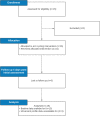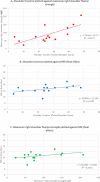A pilot study of a single intermittent arm cycling exercise programme on people affected by Facioscapulohumeral dystrophy (FSHD)
- PMID: 35749388
- PMCID: PMC9231774
- DOI: 10.1371/journal.pone.0268990
A pilot study of a single intermittent arm cycling exercise programme on people affected by Facioscapulohumeral dystrophy (FSHD)
Abstract
For patients affected by Facioscapulohumeral dystrophy (FSHD), alternate methods for increasing physical activity engagement that may benefit shoulder function and wider health are needed. Arm cycling has been proposed as a potential method for achieving this although dosage parameters and evidence is limited. The aim of this study was to conduct a pilot study evaluating the effect of a single intermittent arm cycling exercise programme on people affected by FSHD. People with confirmed genetic diagnosis of FSHD between the ages 18-60 years were recruited to attend a single session for the exercise intervention (5 exercise efforts lasting 2 minutes each with 30 seconds of rest between each effort). Prior to exercise, measures of shoulder function (Oxford shoulder score), strength and range of movement were recorded. During the exercise participants were video recorded to quantify range of movement and extract movement profile features. Participants comments were recorded and followed up four days later to check for adverse events. Fifteen participants, (6F:9M) were recruited with median (IQR) Oxford Shoulder Scores of 25 (18 to 39). All participants successfully completed the exercise intervention with only transient symptoms consistent with exercise being reported and achieving a median (IQR) rate of perceived exertion scores of 13 (12 to 13). Movement profile data was available for 12 out of 15 participants and suggests that exercise intensity did not compromise movement. An association between strength and shoulder function (R2 = 0.5147), Rate of perceived exertion (RPE) of the final effort against shoulder function and strength (R2 = 0.2344 and 0.1743 respectively) was identified. Participant comments were positive regarding the exercise intervention. Our study demonstrates that an intermittent arm cycling programme is feasible for people affected by FSHD. Further work is needed to evaluate physiological responses to exercise across variations in programme variables and equipment set up in a larger sample of people affected by FSHD.
Conflict of interest statement
I have read the journal’s policy and the authors of this manuscript have the following competing interests: I am reporting that Professor Anand Pandyan has received unrestricted educational support from Allergan and Biometrics Ltd., and Honorarium payments from Allergan, Biometrics Ltd, Ipsen, and Merz. These companies are unlikely to be affected by the research reported in the enclosed paper. I have disclosed those interests fully and I have in place an approved plan for managing any potential conflicts arising from that involvement. This does not alter our adherence to PLOS ONE policies on sharing data and materials.
Figures





References
-
- Organization WH. Towards a common language for functioning, disability, and health: ICF. The international classification of functioning, disability and health. 2002.
Publication types
MeSH terms
LinkOut - more resources
Full Text Sources

